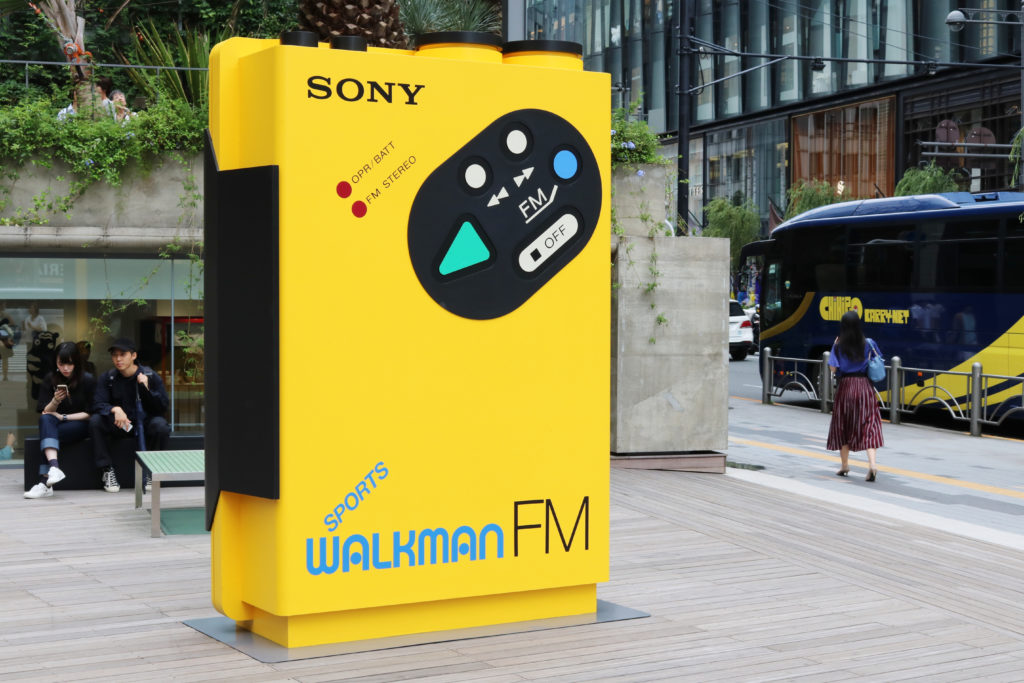
Remember when the Sony Walkman was the hottest gadget around? The photo above was shot in Tokyo this summer, part of the “Walkman in the Park” exhibition. That’s because this year marks the Walkman’s 40th anniversary.
Some of us actually remember what we were doing when the Sony Walkman hit the scene back in 1979. In its day, I would venture to say it had a similar impact to that of Apple’s iPhone decades later.
In 1979, I was working in radio, and the Walkman was like a dream come true. Radio’s portability had been dying out with the transistor radio. The Walkman was like a dream come true if you loved radio and/or music.
In some ways, it was that iPod that rang the death knell for the Walkman as physical music – cassettes, CDs, sound cards – started to become passe. And then the iPhone was the straw that broke its back – and its former hold on media on-the-go.
To a great degree, it was what led us to form jācapps 11 or so years ago – to help bring portability back to radio via mobile apps. But many of us still miss our Walkmans, and the ease in which we could plug in a pair of headphones and go about our day, listening to a favorite morning show, a baseball game, or just music on the radio during a workout.
And so yesterday, Tim Cook announced the newest iteration of that company’s most successful product line ever – the iPhone 11. It has two cameras, and a new array of colors (including lavender), and longer battery life (let’s hope).
The long-term impact of the iPhone and other feature-filled smartphones hasn’t been lost on Sony as it is set to market a 40th anniversary  model of their iconic Walkman. But it’s quite a big different than the original version you may remember from decades ago.
model of their iconic Walkman. But it’s quite a big different than the original version you may remember from decades ago.
It is not your mother’s (or your grandmother’s) Walkman.
First, it doesn’t play cassettes (but it has a nifty feature that looks like it does).
Second, it is powered by Android, enabling music apps.
Third, it will retail for north of $400 (but a cheaper version will soon be released), quite a bit more than you remember paying for your first Walkman (but much cheaper than the new iPhone).
Notably, the 40th anniversary edition Walkman has a headphone jack, unlike most of the smartphones now on the market. Of course, you can still connect listening devices via Bluetooth as well.
And finally, this new 40th anniversary device has a lot of whiz-bang features – but it doesn’t have a built-in AM/FM tuner. If you want to listen to your favorite radio station, you can do so via an app.
So, the other day when this new Walkman was announced, I fired off a tweet about the missing radio, and it quickly stirred up a flurry of opinions.
Most of them came from our friend and futurist James Cridland who made the point that broadcast radio is simply not a big option among the headphone crowd. And to support his contention, he posted a chart from the Midas/RAJAR summer ’19 survey that asked UK respondents about what they listen to via headphones/earbuds. You can check out the full results of this study here.
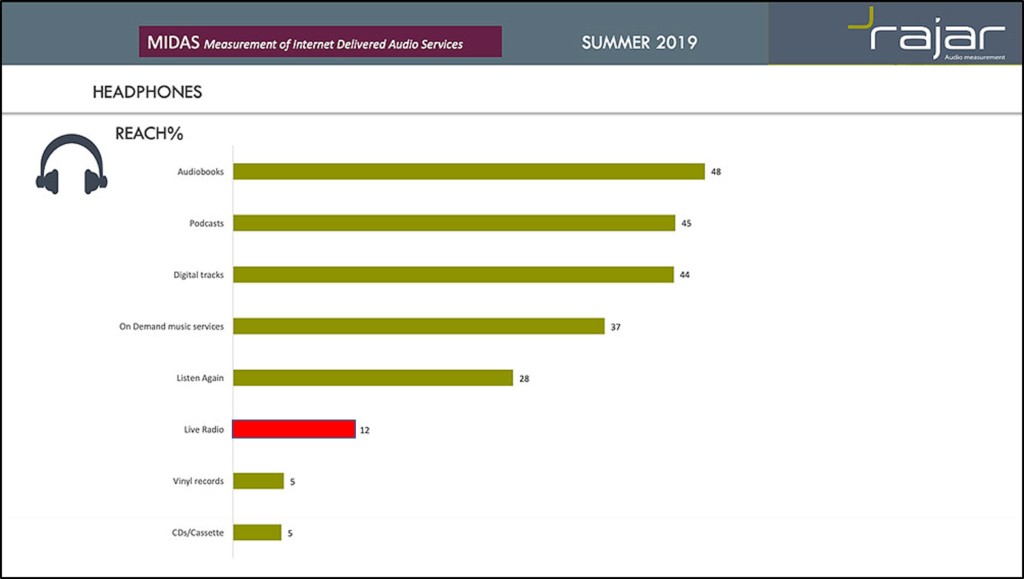
OK, so these are not Americans weighing in, but would it really matter? In his recent AllAccess column, “Radio Futurescope,” James addressed this chart, discussing the best listening applications for headphones.
The title says it all – “Headphones – They’re Not For Live Radio.”
His contention is there’s a distinct difference between listening to audio via speakers or headphones. And pointing to the chart, he views podcasting as being intimate, and throws audiobooks in that same bucket. Then, there are on-demand playlist services – another area where consumers listen to their own music collections on headphones.
But Cridland believes live radio is a much better fit for speakers – including of course devices like Amazon Alexa and Google Home which he refers to as 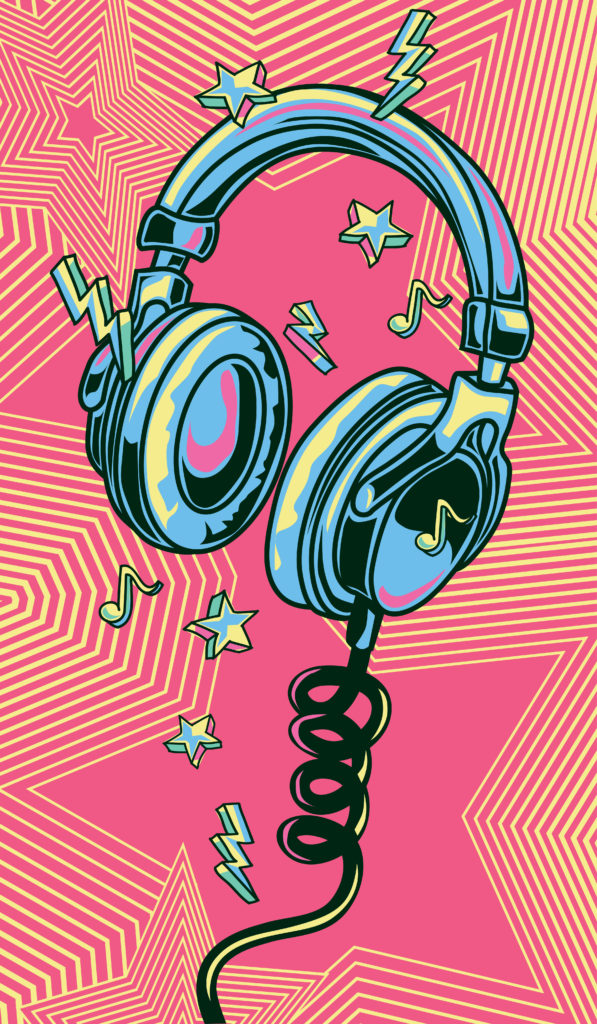 replacements for AM/FM radios.
replacements for AM/FM radios.
Is he right? Is radio no longer a viable medium for headphone listening, contrary to the way it might have been back in those early Walkman days.
Personally – and yes, I’m a focus group of one – a Walkman with an AM/FM tuner built in would have value for me. When I’m working out or it’s over a weekend, listening to sports on the radio is something I look forward to doing.
But with my iPhone, access to radio stations via apps often means those play-by-play games aren’t part of the stream. Similarly, personality radio – in particular – would seem to still lend itself to headphone listening.
We continue to conduct many focus and L.A.B. groups where radio listeners tell us how they shift from gadget to gadget throughout a typical day, depending on whether they’re at home, in the car, at work, or working out.
When they use a mobile device to listen to radio – often at work – headphones are usually involved. Some also tell us they are unable to stream radio stations at work over the company Internet. Thus, their smartphone becomes the conduit.
But this Midas/RAJAR data is compelling, and while it may be more specific to Liverpool than Louisville, it suggests headphone usage has shifted, along with pretty much everything else in the media world.
That said, I went into their report and under their “live radio” findings, I ran across this infographic (below left), a reminder of how live radio continues to be relevant via headphones. After all, 7 hours a week (on average) per listener isn’t exactly bugger all.
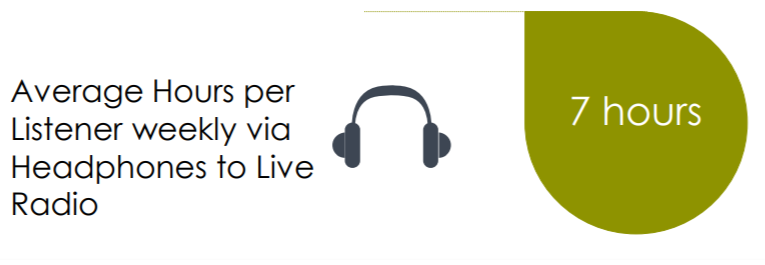
Thus, what started as a fluff post about a new commemorative-issue Walkman turned into a more pointed and important question about broadcast radio’s “fit” with the headphone, ear bud, air pod movement that’s becoming more prevalent with each passing year.
My bet is that many programmers and marketers working in broadcast radio continue to believe the medium continues to be well-suited to 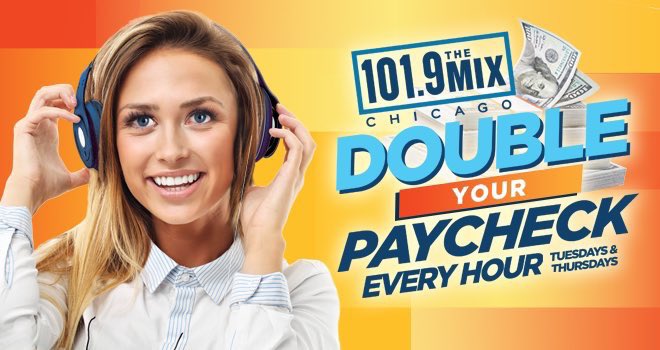 headphone listening. WTMX/Chicago would be one of them, based on its new contest, as well as its marketing leading morning show, “Eric in the Morning.”
headphone listening. WTMX/Chicago would be one of them, based on its new contest, as well as its marketing leading morning show, “Eric in the Morning.”
Is that an incorrect supposition based on past habits? Or is listening to radio on headphones still a viable, marketable activity?
Is there a difference in the types of audio that are most compatible with headphones versus speakers? Or is audio audio?
And is live radio “headphone-worthy?”
A lot of questions. And you can bet we’ll include them in Techsurvey 2020 coming later this fall. It will help provide another important look at the changing audio experience, and how broadcast radio may be impacted.
So, what are YOU hearing?
- What To Do If Your Radio Station Goes Through A Midlife Crisis - April 25, 2025
- A 2020 Lesson?It Could All Be Gone In A Flash - April 24, 2025
- How AI Can Give Radio Personalities More…PERSONALITY - April 23, 2025




How and where you listen to audio is a personal decision with multiple options. There should be no limits to receiving Exceptional Radio Content.
Hi Fred
We had this discussion back when PPM was launched; Nielsen / Numeris are unable to capture radio tuning via headphones, therefore this listening has no commercial value. Tracking has to happen in the listening device.
Best regards
Andrew, I purposely left that part out. James Cridland suggests it’s not a problem anyway because there’s so little headphone listening to radio. I’m not on the page, as you know. And smsartphones with no headphone jack make it even more challenging for meters to capture radio listening. Yet, another challenge facing radio. Thanks for the comment.
Great piece, Fred. Not sure I agree that it isn’t an issue that PPM doesn’t effectively measure headphones in practice, though.
I’d also draw a distinction between music radio and talk radio here. I have no data to back this up, but I would suggest that talk radio performs well on headphones, but music radio doesn’t. (“Talk” in this case might include acts like Elvis Duran, even if he’s on a music station).
I seem to remember some data about the split of music radio to talk radio in terms of total TSL, but can’t remember the figures enough to quote with any confidence.
(I’m puzzled by the “not bugger all” figure of 7hrs/week. It doesn’t seem to tally with the research on headphone use lower down, and means 33% of all radio listening is on headphones, which I simply do not believe).
James, I do think the PPM headphone measurement issue is, in fact, an issue. Arbitron researched it way back when. I’m concerned that as smartphones and listening habits evolve, metered measurement is even more precarious.
But the real reason for my reply is to check to see whether I used “bugger all” correctly.
A key part of this hits home very specifically for me. This past Sunday was a beautiful day in Charm City. I decided rather than watch on TV I preferred to take a drive and listen to the Ravens-Dolphins game on the radio. I wanted to hear our local broadcasters. (The fact that we’re the flagship stations and that my voice would be prominently featured on in-game commercials had ZERO to do with that.) BUT I quickly discerned that if I wanted to leave my car at any time I couldn’t listen on my phone because the NFL blocks all streams. AND … I no longer own a Walkman-like device. (I certainly wasn’t going to PAY to listen to my home team. God forbid.) So … guess what I’m going to do ASAP? Buy a Walkman-like device. Of course that’s assuming they still exist.
Exactly, Harvey. That echoes my experience. I don’t listen to radio all the time using earbuds, but especially on the weekends for sports, I do. And BTW, congrats to the Ravens. Nice start on the season.
Thanks, Fred! But the BIG story is that your Tigers apparently are even worse than my Orioles. I thought the O’s were LOCKS for the #1 pick next year. Can you say “rebuilds?”
I wish this WAS a rebuild. Not seeing the strategy here. Go O’s!
I’m looking for a Walkman radio today. Hope I find one!
Try eBay, Kay.